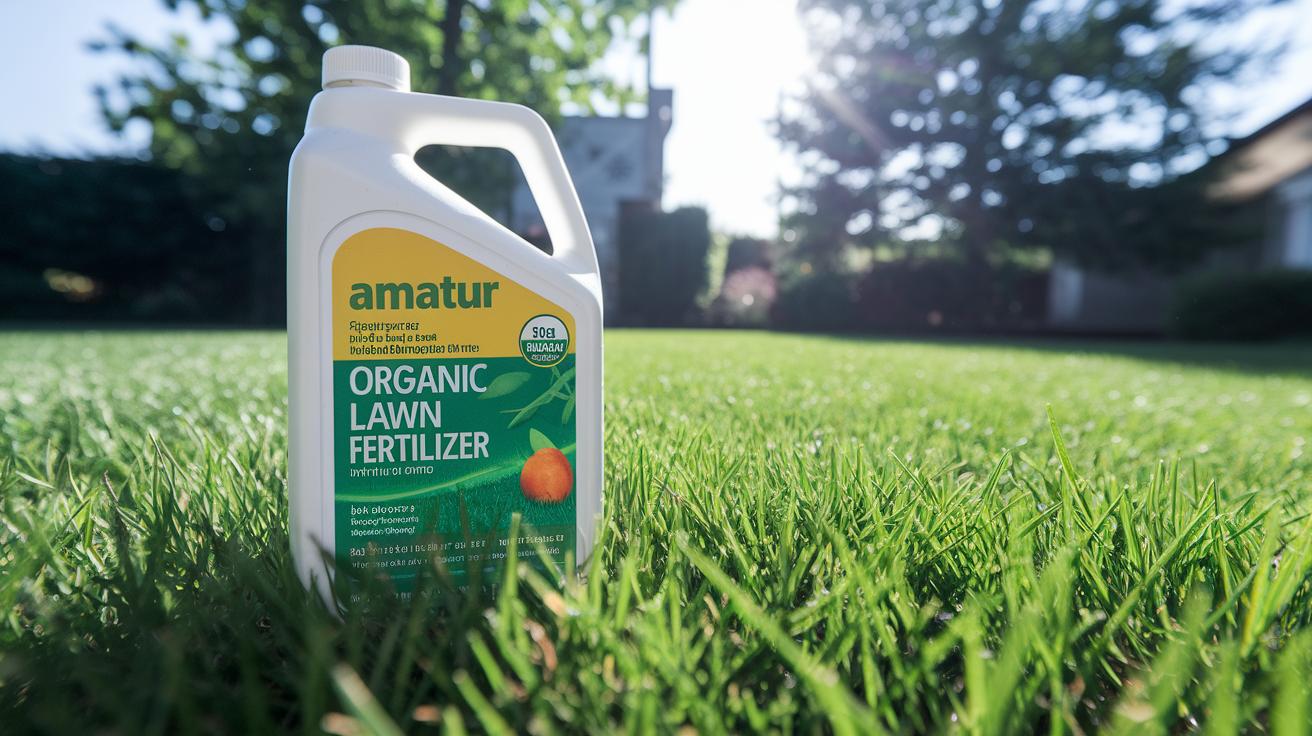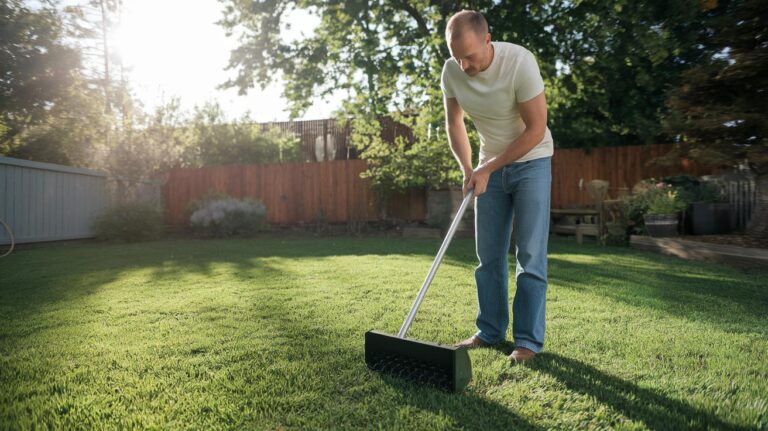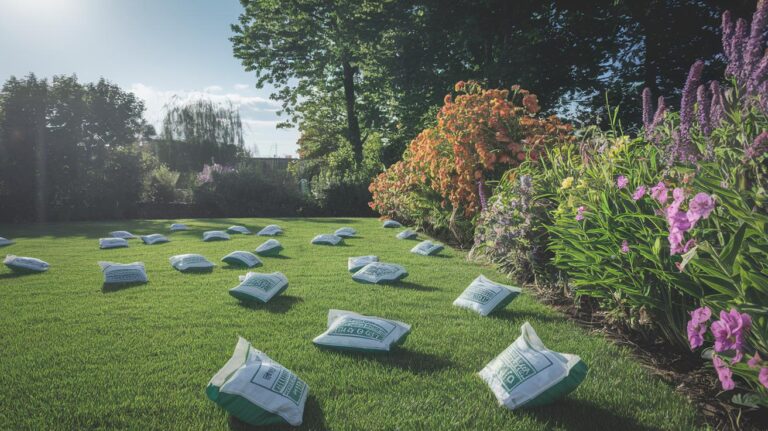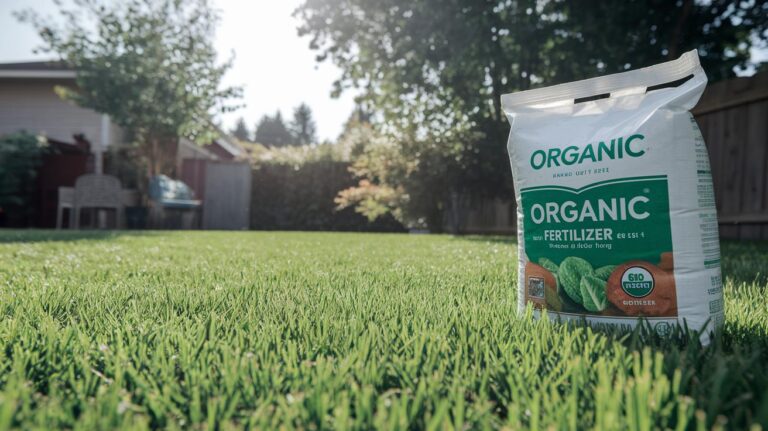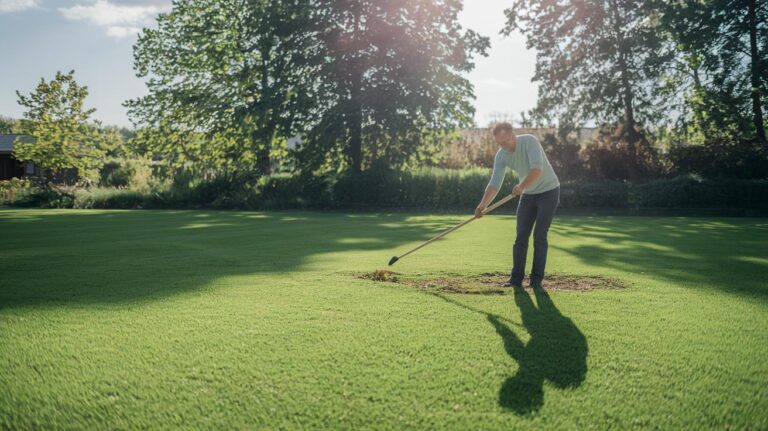Liquid Organic Lawn Fertilizer Boosts Lush Green Lawns
Think grass only greens up with harsh chemical feeds? I thought so too, right? But there’s a gentler way that still gets your lawn glowing.
Liquid organic lawn fertilizer is a water-ready mix that nourishes blade tips and roots without all the rough stuff. Fertilizer (plant food) slides right through your hose-end sprayer. No extra buckets needed.
It pours in seaweed extract (seaweed mix full of natural minerals), fish emulsion (liquid fish mix for a quick green boost), compost tea (liquid brew of composted matter that adds living microbes), and humic acids (natural acids that help soil hold onto nutrients).
With every spraying, your leaves look deeper green and your soil grows healthier. You can feel the earth crumbling like soft cake between your fingers.
That’s why it’s my go-to for a plush, velvet-like lawn you’ll love stepping on.
Overview of Organic Liquid Lawn Feeds
Liquid organic lawn fertilizers blend seaweed extract, fish emulsion, compost tea, and humic acids into a water-soluble mix that delivers nitrogen, phosphorus, potassium, and micronutrients instantly. These natural liquid lawn nutrients support soil health by feeding beneficial microbes, improve water retention through better organic matter, and cut chemical runoff compared to synthetic feeds. Many gardeners call this the best organic liquid lawn fertilizer when they want steady green growth without harsh chemicals. Typical dosing runs 1–4 ounces per 1,000 sq ft, mixed with water in a hose-end or backpack sprayer. Learn more about organic fertilizer for lawn, then check out How to Apply and Top-Rated Products & Pricing Guide for full details.
Natural Ingredients in Liquid Organic Lawn Fertilizer: Seaweed, Fish Emulsion & More
Quality ingredients set the stage for healthier turf. When seaweed, fish emulsion, compost tea, and humic acids come from well-made sources, they deliver nutrients and living microbes that feed grass and soil biology more reliably.
-
Seaweed extract
Seaweed extract brings a blend of trace minerals and natural growth hormones that help grass bounce back after stress. It also contains tiny bits of plant matter that feed helpful bacteria in the soil. -
Fish emulsion
Fish emulsion lawn fertilizer balances nitrogen, phosphorus, and potassium at about 5-1-1, giving leaves and roots a quick boost. This gentle feed works fast without scorching tender grass blades. -
Compost tea
Compost tea (a liquid brew of composted organic matter) pours in living microbes and organic carbon that improve soil texture and water-holding capacity. Over time, it helps turf resist drought by keeping soil more sponge-like. -
Humic acids
Humic acids (organic compounds from decayed plant matter) coat soil particles so nutrients stick around longer. They also open tiny pores in clumped soil, making it easier for roots to spread.
All four ingredients team up to kick-start microbial activity, build crumbly soil structure, and give grass the steady supply of nutrients it needs. Some blends even add amino acid mixes or microbial inoculants for an extra layer of support in challenging conditions.
How to Apply Liquid Organic Lawn Fertilizer: Dosage, Equipment & Timing
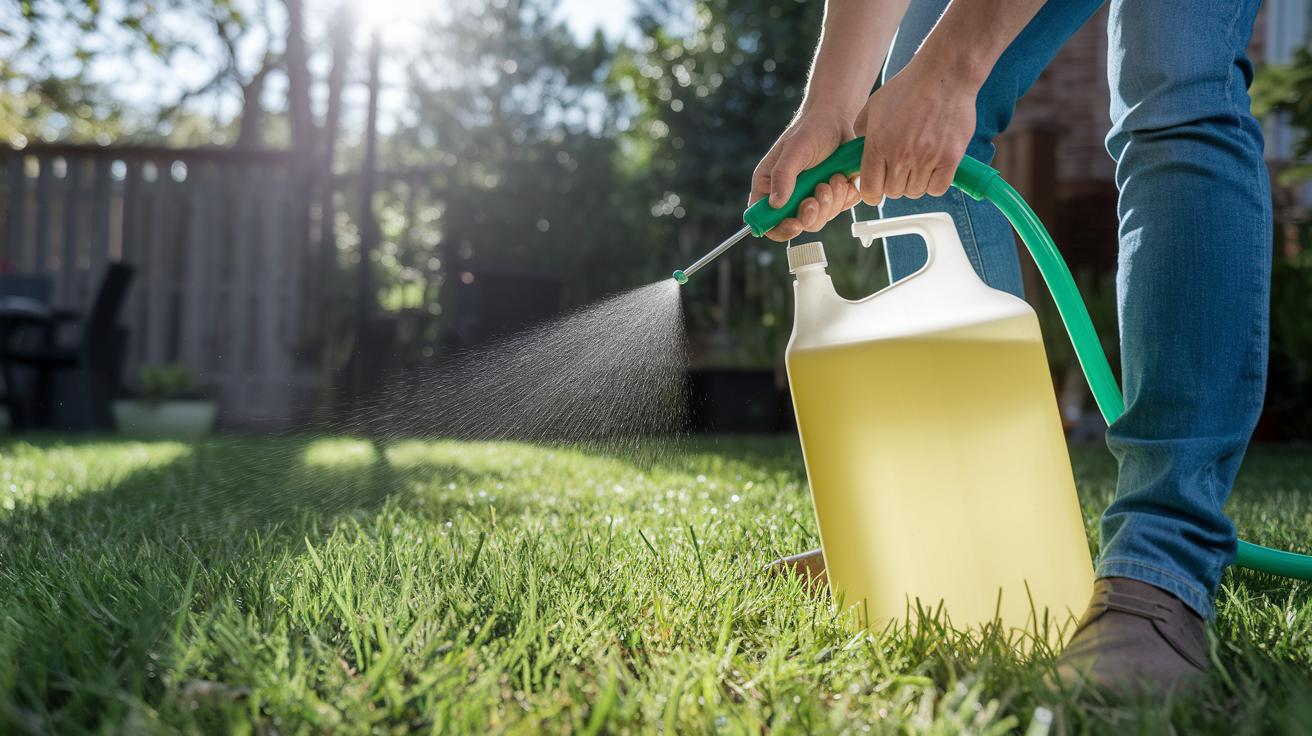
Aim for 1 to 4 ounces of concentrate (strong liquid fertilizer) per 1,000 square feet (about the size of a tennis court). One ounce gives your grass a light pick-me-up. Four ounces is more of a hearty meal. You’ll see blades go from pale to a happy green and feel the soft earth under your toes. Feed every 6 to 8 weeks during the growing season. If you skip one, your lawn might look tired and thin. I set a phone reminder so I don’t forget, oops, learned that the hard way.
Start mixing in a clean bucket or container. Give the bottle a good shake before you pour. Add the measured concentrate into water, slow and steady helps avoid suds or splashes. Then stir again so nutrients are evenly floating around in the tank. When it’s uniform, each spray gives every blade the same strength boost.
Grab a hose-end sprayer (tool that snaps onto your garden hose) or a backpack sprayer (a shoulder-worn tank and wand). With a hose-end sprayer, clip it on, turn the water gently, and watch how it picks up the mix. Let a little water spray first to check for heavy spots. If you’re using a backpack sprayer, lock the nozzle at low pressure so droplets stay fine, like a light mist. Walk at a steady pace, don’t rush, so you don’t leave stripes or bare patches.
Wait until soil temperatures hit about 55 °F before you spray, roots (the underground part that drinks nutrients) are more active then. Early morning or late evening is best because cooler air means less evaporation. After spraying, run your sprinkler for a minute or two to wash the feed down into the root zone (where the roots live). Finally, rinse out your sprayer parts, nozzle, tank, hoses, so leftover bits don’t clog up next time.
Seasonal Schedules for Liquid Organic Lawn Fertilizer: Spring Through Fall
When your soil temperature (the heat in the soil) climbs above 55°F in March or April, it’s time for that first splash of liquid organic lawn fertilizer (liquid plant food that helps roots grow). This spring pick-me-up shakes winter’s sleep off your grass. It sends food down into roots and teases out bright green blades. But first, run a soil test so you know exactly which nutrients your yard is craving. By the way, did you spot that robin hopping around? Back to feeding.
In late spring, once those first shoots have burst through, give your turf a second pour of fertilizer. This little boost keeps grass thick, soft, and ready for summer. Walking barefoot on this cozy green carpet? Pure joy.
When the July sun pounds down and dry spells sneak in, your grass might start to wilt. That’s when your mid-summer liquid plant food comes in. Mix it in and water gently so moisture settles into each crown (the top of the grass plant). It helps your lawn bounce back and stand up to heat. Oops, I almost forgot to water in after feeding, don’t let that happen!
Come early fall, your lawn is ready for one more treat. A fall feed pushes energy down into roots so they stock up for winter rest. Cool air and dewy mornings are just around the corner, but underground your roots will be busy tucking away food. Planting now sets you up for a springtime show.
Comparing Liquid vs Granular Organic Lawn Fertilizers
Have you ever noticed how a quick rain can make your lawn pop? Liquid fertilizer (plant food mixed with water) works just like that rain. It drifts right onto grass blades and into the soil in one go. So your grass turns green fast.
Each drop lands where you need it. You get a smooth coat of nitrogen (nutrient that helps green growth), phosphorus (nutrient for roots), potassium (nutrient for strong stems), and tiny nutrients. And it wakes up soil microbes (tiny helpers that break down matter). Oops, I spilled the mix once. But you live and learn.
But here’s the catch. You must measure just right and mix it up. Then spray every six to eight weeks with a hose-end or backpack sprayer. And clean it fast so the old mix does not clog the parts. It takes a bit of care.
On the other hand granular fertilizer (tiny dry pellets) is simple. You pour it out with a spreader, no mixing gear needed. It breaks down slow. That means it feeds grass roots for weeks without babysitting.
Coverage might not be perfect. You may spot stray pellets on the sidewalk. And the green-up is gentler. Soil life wakes up more slowly compared to liquid feeds. But it is easy. A beginner’s dream.
| Format | Ease of Use | Release Speed | Coverage | Best For |
|---|---|---|---|---|
| Liquid | Mix carefully | Fast | Very even | Frequent feeding and soil boost |
| Granular | Spread easily | Slow | Varies | Low-maintenance feeding |
Liquid Organic Lawn Fertilizer Boosts Lush Green Lawns
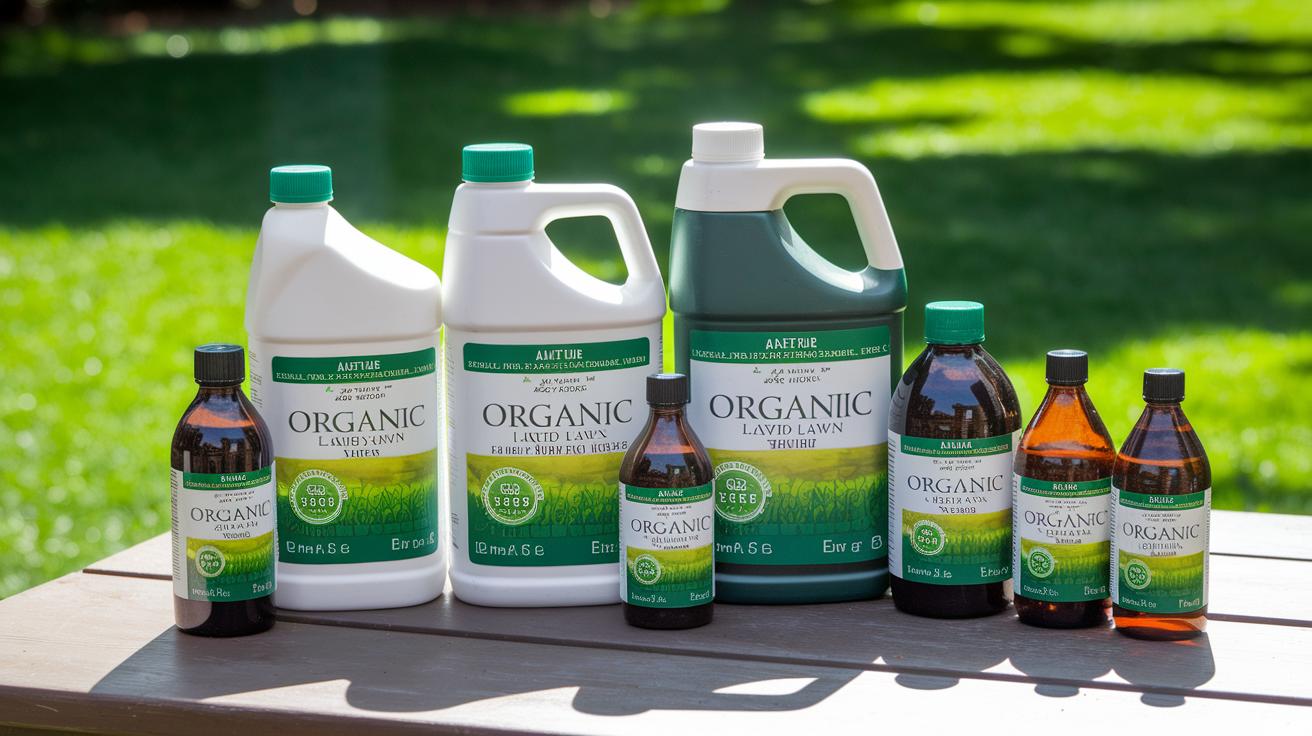
Picking an organic lawn feed can feel like a maze. You head to the store and see rows of bottles. You want green grass without harsh chemicals. So we read reviews and tried a few to find four top liquid organic fertilizers.
Each one mixes easy in a hose‐end sprayer or backpack tank. They range from fish‐based boosts to seaweed tonics. By the way, my dog rolls around on the greenest spots as soon as I spray. Prices go from $15 to $40 depending on bottle size and bonus extras.
- Product A (32 oz, $20): 3-1-2 ratio of nitrogen (helps blades grow), phosphorus (makes roots strong), and potassium (aids stress resistance). It also has iron and zinc (minerals plants need). Just shake, pour, and let the warm earth soak it in. I use this on my small lawn and even in potted planters.
- Product B (1 gal, $35): Fish emulsion with a 5-1-1 ratio. It might smell fishy, but pure fish oil and bone broth feed your soil microbes (tiny helpers that turn food into nutrients). You’ll see quick green-up and stronger roots in about a week.
- Product C (32 oz, $25): Seaweed extract packed with humic acids (organic molecules that fluff soil). It floods your turf with natural growth hormones and trace minerals. The humic acids hold water so the soil stays soft and damp under hot sun.
- Product D (32 oz, $30): Microbial inoculant concentrate. This adds good bacteria and fungi (tiny life that breaks down organic matter). Use it every other feeding to boost soil life. Your turf will feast on slow-release nutrients all season.
Choosing the right concentrate is about matching yard size, strength needs, and budget. Then just mix, spray, and step back. Enjoy lush green grass that feels alive under your feet.
Environmental & Safety Benefits of Liquid Organic Lawn Fertilizer
Have you ever sprayed a fine mist over your lawn and felt the cool droplets settle on the blades? When you use liquid organic fertilizer made of seaweed extract, fish emulsion (liquid fish remains that feed plants), and compost tea (nutrient-filled plant brew), nutrients slip into the tiniest soil pores. That cuts down on runoff during heavy rains. It also helps your yard hold onto more water so roots can drink.
More organic matter means richer, looser soil. Those lively microbes nibble away at compacted dirt until it crumbles between your fingers. So when dry spells hit, your grass won’t gasp for moisture. You’re saving real water here and boosting soil life at the same time.
This blend is so mild it’s safe for kids and pets. No harsh chemicals lurking under bare feet. Little ones can chase butterflies and dogs can roll around without you shouting, “Oops, watch out there!” By the way, my pup loves this soft, lush turf.
And hey, no more smelly bags of powder strewn on your sidewalks. Just spray, soak in the sunshine, and forget it. Grass stays vibrant and ready for backyard games. Your whole crew can kick back on a healthy lawn with zero worries.
Final Words
In the action, we outlined what organic liquid lawn feeds are, their top benefits over chemical options, and tips for dosing plus product pointers.
You also dug into natural liquid lawn nutrients like seaweed extract, fish emulsion, compost tea, and humic acids before learning application steps, ideal timing, and seasonal feeding schedules.
Comparing liquid vs granular options and highlighting top-rated picks made choosing the right solution easier, and the eco-friendly, safe-around-kids-and-pets benefits seal the deal. Embracing liquid organic lawn fertilizer means you’ll get a lush, healthy yard with minimal effort and plenty of garden smiles.
FAQ
What is the best organic liquid lawn fertilizer?
The best organic liquid lawn fertilizer blends seaweed extract, fish emulsion, and humic acids for fast nutrient uptake, even coverage, and a boost in soil microbial activity suited to most turf types.
Where can I buy liquid organic lawn fertilizer?
You can buy liquid organic lawn fertilizer at local garden centers, farm supply stores, or online retailers like Amazon and specialty lawn care sites—choose concentrate or ready-to-spray options to fit your sprayer.
What are the disadvantages of liquid organic fertilizer?
Liquid organic fertilizer drawbacks include more frequent applications, precise mixing requirements, and higher cost per treatment. Regular sprayer cleanup is needed to prevent clogs or corrosion.
Are organic liquid fertilizers effective for lawns?
Organic liquid fertilizers are effective for lawns by delivering immediately available nutrients, improving soil structure, and boosting root health. Their fast-acting formula supports greener, more resilient turf with low burn risk.
Can I use liquid lawn fertilizer concentrate with a sprayer?
Liquid lawn fertilizer concentrate works in hose-end and backpack sprayers when diluted at label rates. Stir the concentrate thoroughly, measure accurately, then spray evenly for uniform feeding.
Do lawn care professionals use liquid fertilizer?
Lawn care professionals often use liquid fertilizer for quick nutrient delivery, precise feeding schedules, and enhanced soil biology—ideal for addressing heat stress in summer or building strong roots in fall.

